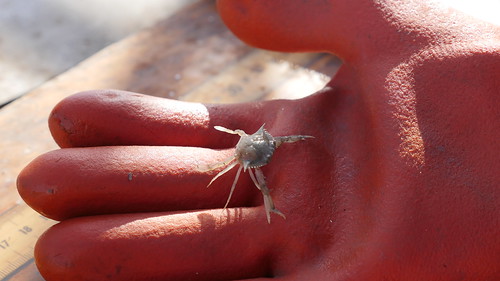Maryland and Virginia to Review Survey Results, Decide Management Approach

Staff examine a juvenile blue crab as part of the annual winter dredge survey; photo taken in 2017. Photo by Stephen Badger, Maryland Department of Natural Resources.
The Maryland Department of Natural Resources (DNR) announced the results of the 2022 Baywide Blue Crab Winter Dredge Survey, a cooperative effort with the Virginia Institute of Marine Science (VIMS), which annually estimates the number of blue crabs in the Chesapeake Bay.
The total abundance of blue crab in the Chesapeake Bay in 2022 was 227 million crabs, the lowest abundance observed since the survey began in 1990. The number of juvenile crabs in 2022 was 101 million crabs, a slight increase from 86 million juvenile crabs in 2021, but the third consecutive year of below average recruitment.
Blue crab reproduction is naturally variable and it is difficult to identify a singular reason for the recent period of low juvenile abundance. Larval blue crabs develop in ocean waters over the continental shelf and many factors can influence recruitment success such as oceanic conditions, available nursery habitat, predation, and other environmental conditions. Given the recent shift, the Chesapeake Bay Stock Assessment Committee is planning a workshop for fall 2022 to explore potential recruitment drivers.
Despite low abundance, the number of spawning age female crabs has been above the management threshold of 72.5 million crabs for eight consecutive years and at a level capable of producing a strong year class. The spawning age female abundance decreased from 158 million crabs in 2021 to 97 million crabs in 2022. Additionally, the results showed there were 28 million adult male crabs, which is the lowest adult male abundance on record.
The Chesapeake Bay jurisdictions have maintained harvest of blue crabs at safe levels set forth in the last benchmark stock assessment since 2008. Despite meeting these management objectives, adult blue crab abundance has steadily declined. DNR will be working with partners in Virginia and the Potomac River Fisheries Commission on a coordinated approach to set management measures for the 2022 crabbing season that address the conservation needs of the resource.
The Chesapeake Bay Stock Assessment Committee will review the survey results and provide their scientific advice for management during their May meeting. Following their advice, DNR will begin discussions with the Blue Crab Industry Advisory Committee to provide guidance concerning the course of action for 2022 that promotes the health and sustainability of the Chesapeake Bay blue crab population and its fisheries.
The Winter Dredge Survey has been conducted cooperatively by DNR and VIMS since 1990, and the results are reviewed annually in an effort to have consistent management efforts across the jurisdictions. Throughout the survey, biologists use dredge equipment to capture, measure, record and release blue crabs at 1,500 sites throughout the Chesapeake Bay from December through March. Detailed results are on the DNR website.
